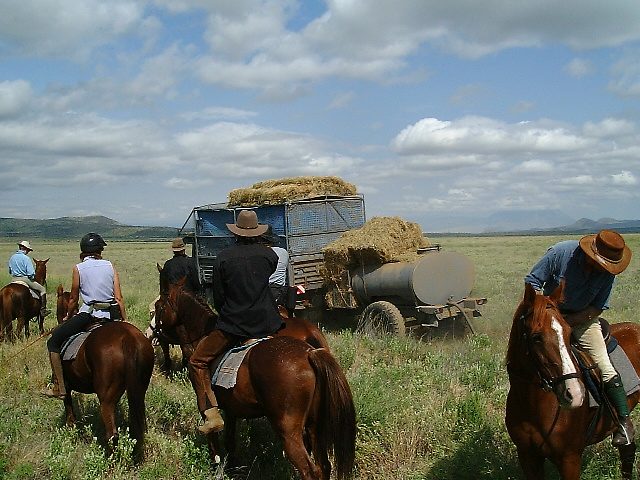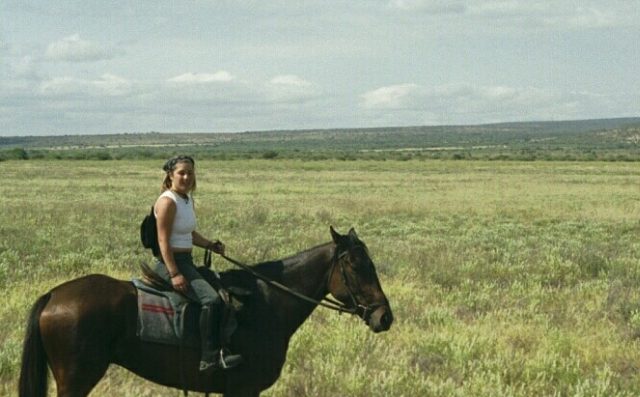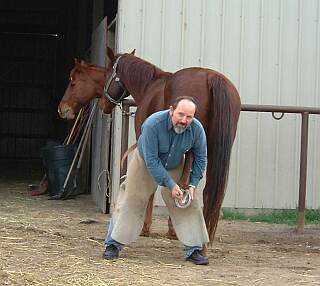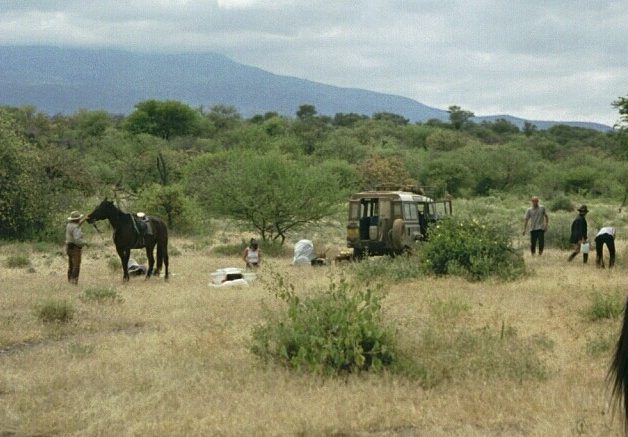Morning broke rather overcast. It wasn't worth
taking pictures of the camp this morning because of the poor lighting.
After breakfast we began a ride that was to cover many, too many miles
that day. We started from Camp 3 in a west by southwest direction
with Mt. Kitumbeine on our left and Mt. Gelai on our right (more or less).
When we could see it, we were heading in the general direction of Oldoinyo
Lengai.
My riding sores (A.K.A. - butt blisters)
were getting no worse and were actually improving. The improvement
in my riding sores was due to at least one or more factors. First,
Stefan decided his seat saver was causing him problems and I could have
it if I wanted it. Although it was not made of genuine sheepskin,
I gladly took it and started using it. It helped. Finally I
got smart and removed the rear patch pockets from my riding jeans.
Lastly, I was riding in a different saddle that fit me better. You
know, I have no idea which one of these changes was the most effective,
but riding was a bit more comfortable now.

There were zebras and these ostriches
out on the open grasslands.
Same view taken by Dr. Kolblinger

About midmorning we were riding along when ----

when we heard the Bedford making for the next camp.

Nice picture of Annabelle
If I remember correctly, it was this morning
that I noticed that Tom's horse had lost a front shoe. Up to now,
I had been monitoring the feet of my horse to make sure it hadn't lost
any shoes, but hadn't noticed the feet of the other horses.
Now I started looking around and noticed that a couple of other horses
had lost at least one shoe. I also noticed that some of the horses
had never had their rear feet shod in the first place.
So what's the big deal with me and the horses'
feet? I'll tell you, if I know anything about horses (and I admit
that's not much) I know feet and shoeing. For over 16 years I've
been doing trimming and "cold" shoeing for my own horses and on rare occasions,
for friends. I can't possibly remember all the times I've straightened
out bent shoes and nailed them back on for friends way out in the middle
of nowhere. When I was active with my Civil War Cavalry reenactments,
I was the "Company Farrier" and I always keep my tools nearby in my trailer
when I go on rides.
No, I'm not a professional farrier, but I
have taken the short class in shoeing at Cal Poly University up at San
Luis Obispo. One big difference between me and a pro is that I'm
very slow, slow but careful. Another difference between me and a
lot of old time shoers is that my nail cinches are very slight. If
the horse steps on the edge of his shoe (and that's how 99.9% of shoes
are lost), I want the shoe to pull off cleanly rather than take a hunk
of hoof wall with it. Surprisingly, my shoes stay on just as long
and just as well as shoes with heavy cinches.

That's me (facing the camera).
OK, here's the scoop on when and how many shoes
to put on horses:
Those horses that live their lives on dirt
or sand and with only occasional walking on hard ground should not have
shoes put on them, but should be trimmed every 6 to 8 weeks. Of course,
if the horse has a pathological condition that requires "corrective shoeing"
that advice is wrong. However, I've found it true for over
90% of the horses I've dealt with. All trimming should follow the
natural wear pattern of that horse's foot and the foot should not be trimmed
any shorter than necessary to keep the hoof from flairing or cracking.
Now, having said that, if the horse is going
to be used day after day and especially if it is going to be used over
rocky or otherwise hard ground, shoes are absolutely necessary. It's
true that there are rare horses with feet so thick and so tough they don't
need shoes - ever. I used to ride one like that. His name was
Iron Mike. He was a huge and wonderfully natured Appaloosa gelding
with feet like iron. His feet grew so fast and so thick that you
couldn't wear them down. Iron Mike was the only horse I've ever dealt
with personally that had feet like that though.
If the horse will be used infrequently over
rocky ground and if he has good strong hoofs, the horse may do well with
shoes on the front feet only. This arrangement usually works out
well because the rear feet of horses are almost always tougher than the
front feet and it's cheaper and healthier.
Nevertheless, if the horse is going to be exposed
to sharp, cobble sized rocks and hard abrasive ground for hours or days
at a time, then thick, wide webbed shoes on all four feet are absolutely
necessary. Anything less is cruel as the unprotected foot will wear
down and expose the sensitive corium of the foot to painful pressure and
bruising. If you don't care about the pain you're inflicting, consider
that the horse will move much more slowly and reluctantly as it tries to
pick its painful way across hard ground. Consider too that you may
have to take an undesirable route in an attempt to find softer footing.
Oh yes, you may have to take some very, very undesirable routes if the
horses feet aren't protected properly. We'll see just how true that
is when we get to Lake Natron section of this story.
Well, I'll bet you think I've just about beaten
this shoeing subject to death, haven't I? Oh no I haven't (as you
will see later), but let's get on with the story and get back to the horses'
feet later.
When I saw that Tom's horse had lost a front
shoe I told him that I was experienced in farrier work and I'd be very
happy to assist them in keeping shoes on the horses. I was a little
puzzled when he mumbled something about not needing any help - thank you
very much - but they could handle everything without any help from the
guests. I took that answer to mean that they had all the spare shoes,
tools and expertise they needed for any shoeing job. Then I asked
Tom how far back the horse had lost the shoe. He said it was yesterday
some time - I didn't say anything, but I was thinking: "Yesterday?
Gee, why hadn't they replaced the shoe last evening or before we started
out this morning?" Oh well, it was their horse and they'd probably
replace the shoe tonight or tomorrow morning. I was eager to watch
them do the job because there's always something to learn from the way
others do things. At this time I did not suspect that they had neither
the tools, the spare shoes and nails or the least expertise with regard
to shoeing horses.
We continued to ride pretty much in a straight
line in that west southwest direction. With few things to interfere
with our progress, we covered a lot of ground before we met up with the
Land Rover and stopped for lunch. As always, the spot chosen for
lunch was the prettiest and shadiest area around. I seem to remember
that it was a bit hot and dry out there, but lunch was nice. We were
now almost exactly between Mts. Gelai and Kitumbeine.
Lunch stop 4.
2 degrees, 44.237 minutes South Latitude
36 degrees, 12.289 minutes East Longitude
3339 Feet above Sea Level
Terry in the center "sleeping anywhere, anytime"
We seemed to have a little delay getting going
after lunch this day. As I remember, it was pretty hot out and I
was a little reluctant to leave the shade trees for that hot sun.
Somehow I ended up holding a horse for quite some time while Janice and
Annabelle were busy rearranging tack or something.

I may get mad at them, but they know who loves them.
For some reason we had a little delay while horse
assignments were sorted out.
Picture compliments of Dr. Kolblinger.
Go to Chapter 11
Return to table of contents